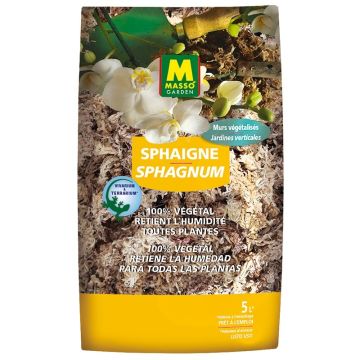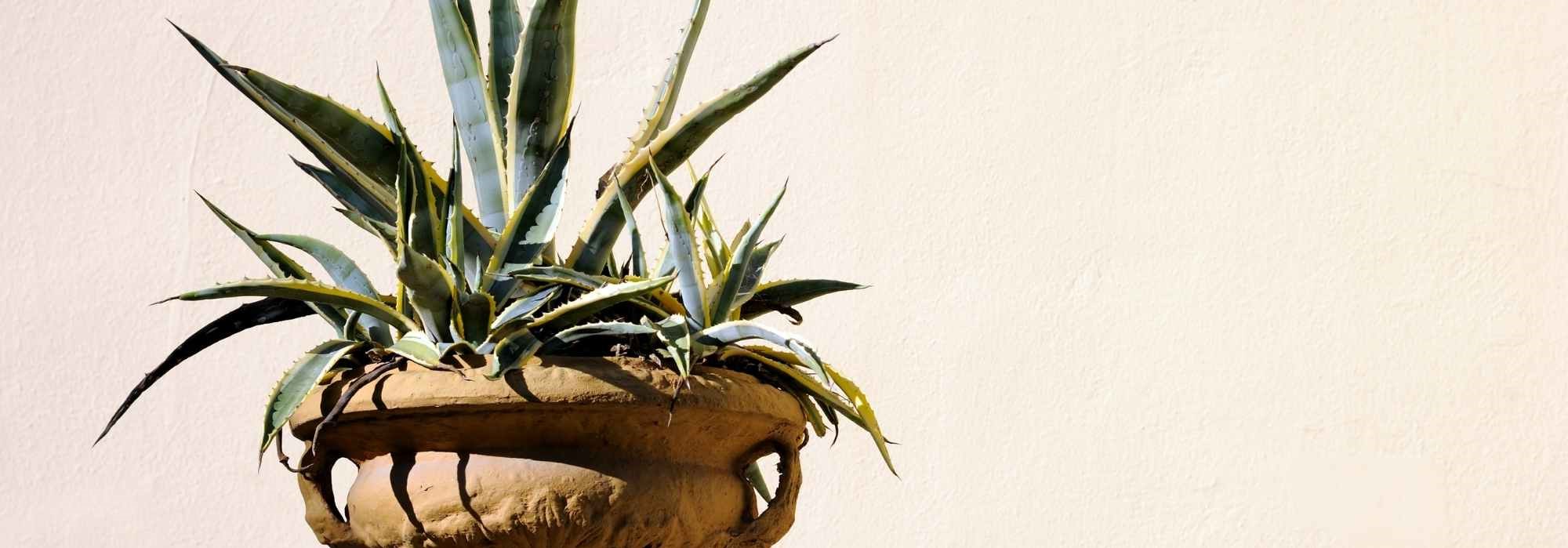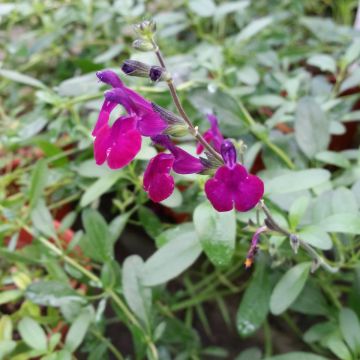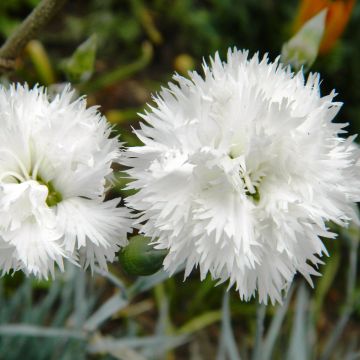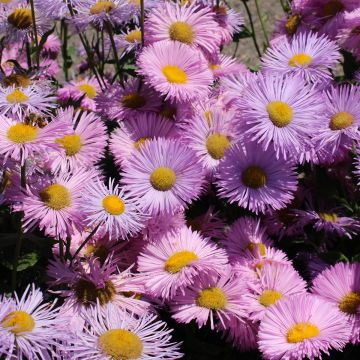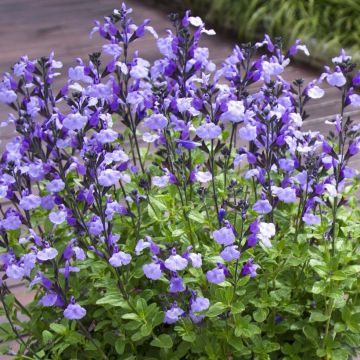

Agave potatorum Kichiokan - Verschaffelt Agave
Agave potatorum Kichiokan - Verschaffelt Agave
Agave potatorum Kichiokan
Butterfly Agave, Verschaffelt Agave
Special offer!
Receive a €20 voucher for any order over €90 (excluding delivery costs, credit notes, and plastic-free options)!
1- Add your favorite plants to your cart.
2- Once you have reached €90, confirm your order (you can even choose the delivery date!).
3- As soon as your order is shipped, you will receive an email containing your voucher code, valid for 3 months (90 days).
Your voucher is unique and can only be used once, for any order with a minimum value of €20, excluding delivery costs.
Can be combined with other current offers, non-divisible and non-refundable.
Home or relay delivery (depending on size and destination)
Schedule delivery date,
and select date in basket
This plant carries a 12 months recovery warranty
More information
We guarantee the quality of our plants for a full growing cycle, and will replace at our expense any plant that fails to recover under normal climatic and planting conditions.
Does this plant fit my garden?
Set up your Plantfit profile →
Description
The Agave potatorum 'Kichiokan' is a horticultural variety with a compact size and a variable appearance depending on the subjects. Well adapted to the Mediterranean climate, this perennial plant forms a sculptural rosette. With a grey-blue colour in adulthood, its regular geometric shape is particularly aesthetic, especially as its dark red thorns create a superb contrast. Highly drought-resistant, this Agave can be grown in a pot in most parts of France and brought indoors in winter to protect it from frost and humidity. On the Mediterranean coast, it will integrate perfectly into a succulent bed and will tolerate a semi-shaded exposure quite well.
The Agave, once a flagship member of the Agavaceae family, is now classified in the Asparagaceae family, alongside the astonishing Ophiopogon or the well-known Cordyline. The Agave genus is rich with approximately 270 species, some almost dwarf-like, and others measuring several meters in width and height. The Agave potatorum is native to the mountainous areas of central-southern Mexico (states of Puebla and Oaxaca), where it grows at altitudes ranging from 1300 to 2300 m. Not exceeding 80 cm in diameter, it often presents a quite variable appearance from one plant to another, making it difficult to identify with certainty.
'Kichiokan' is probably a Japanese cultivar of the species type, but some specialists rather see it as a form of Agave parryi. Like the species type, its morphology varies significantly from one subject to another, with some even having variegated leaves. In any case, its growth is slow, and its adult dimensions remain smaller than those of the botanical species. After many years, it will reach a diameter of 45 cm and a height of 40 cm, rarely more. The plant forms an extremely geometric rosette, composed of imbricate leaves at the center, erect vertically, then gradually opening horizontally. The juvenile leaves are elongated like swords, but as the rosette densifies, their morphology evolves, as does their colour. Initially green (variable depending on individuals), the leaf turns to a grey-blue or glaucous green. It also takes on a characteristic shape. Narrow at the base, it widens towards the top then abruptly narrows, forming a sharp V at the end. Its overall appearance is that of a very asymmetrical diamond, curved in the center like a large spoon, with both edges meeting and ending in a sharp point, 2 cm long or more, hazardous for hands and eyes. Besides this dark reddish-brown tip, the leaf is also armed with curved teeth of about 0.5 to 1.5 cm, equally harmful if handled without gloves. The colour of the teeth contrasts pleasantly with the glaucous leaf surface, adding an ornamental feature to this Agave, whose geometric regularity is fascinating. Mature plants can bloom (often after 15 or even 20 years), producing a tall and spectacular flower spike of 2 or 3 m in height, bearing numerous horizontal branches. These are adorned with a multitude of small tubular flowers in yellow-green. The rosette, classified as semelparous, dies after flowering, which lasts several months. Some plants produce a few daughter rosettes on their trunk, just below the mother rosette.
Easy to grow in a pot to enjoy in cooler climates and bring indoors in winter, the Agave potatorum 'Kichiokan' will find its place even in the smallest gardens on the Mediterranean coast. Create a superb scene by combining it with other ornamental plants for dry soils, such as Hesperaloe parviflora, or "Red Yucca". In reality, this perennial from the same family as the Agaves forms a clump of very fine leaves, above which elegant coral-red flower spikes develop in summer. Also explore the wide range of Opuntia, the famous Prickly Pear cacti with ephemeral but magically beautiful flowers, whose very graphic shapes will blend perfectly with that of your small Agave.
Agave potatorum Kichiokan - Verschaffelt Agave in pictures


Flowering
Foliage
Plant habit
Botanical data
Agave
potatorum
Kichiokan
Asparagaceae
Butterfly Agave, Verschaffelt Agave
Agave saundersii , Agave scolymus
Central America
Planting and care
Plant Agave potatorum 'Kichiokan' in full sun or even partial shade, as this species tolerates it well. Plant it in a preferably poor soil, even rocky, limestone, sandy, but very well-drained. It does not tolerate winter moisture and cold well, but much prefers dry cold in dry soil. It is best to protect this plant from moisture in regions with rainy winters, through a temporary waterproof shelter that allows light to pass through, such as a transparent plastic tarpaulin. If this setup is not aesthetically pleasing, it has the merit of saving the life of this rare plant. As it perfectly tolerates dry, even arid soils in summer, one could, for example, dig a pit of 50 cm, fill it with a mix of rocks and light soil, and plant the agave, with its collar isolated from stagnant water. The drier the soil, the more it will resist frost, up to about -7°C. Ideally, plant it on a slope, tilting it so that water cannot stagnate in the rosette.
As the plant has a rather modest growth, it can be grown in a pot on the terrace or balcony, in a light substrate such as cactus soil, with careful drainage, preferably in terracotta. Water regularly in summer, but let the substrate dry between waterings. It will then be easy to store the pot away from severe frosts and moisture, in a bright, airy, lightly heated or unheated room. Reduce or stop watering in winter. The plant can spend the nice season, from April to October, outdoors.
Be sure to wear protective gloves when handling this plant.
Planting period
Intended location
Care
Planting & care advice
This item has not been reviewed yet - be the first to leave a review about it.
Similar products
Haven't found what you were looking for?
Hardiness is the lowest winter temperature a plant can endure without suffering serious damage or even dying. However, hardiness is affected by location (a sheltered area, such as a patio), protection (winter cover) and soil type (hardiness is improved by well-drained soil).

Photo Sharing Terms & Conditions
In order to encourage gardeners to interact and share their experiences, Promesse de fleurs offers various media enabling content to be uploaded onto its Site - in particular via the ‘Photo sharing’ module.
The User agrees to refrain from:
- Posting any content that is illegal, prejudicial, insulting, racist, inciteful to hatred, revisionist, contrary to public decency, that infringes on privacy or on the privacy rights of third parties, in particular the publicity rights of persons and goods, intellectual property rights, or the right to privacy.
- Submitting content on behalf of a third party;
- Impersonate the identity of a third party and/or publish any personal information about a third party;
In general, the User undertakes to refrain from any unethical behaviour.
All Content (in particular text, comments, files, images, photos, videos, creative works, etc.), which may be subject to property or intellectual property rights, image or other private rights, shall remain the property of the User, subject to the limited rights granted by the terms of the licence granted by Promesse de fleurs as stated below. Users are at liberty to publish or not to publish such Content on the Site, notably via the ‘Photo Sharing’ facility, and accept that this Content shall be made public and freely accessible, notably on the Internet.
Users further acknowledge, undertake to have ,and guarantee that they hold all necessary rights and permissions to publish such material on the Site, in particular with regard to the legislation in force pertaining to any privacy, property, intellectual property, image, or contractual rights, or rights of any other nature. By publishing such Content on the Site, Users acknowledge accepting full liability as publishers of the Content within the meaning of the law, and grant Promesse de fleurs, free of charge, an inclusive, worldwide licence for the said Content for the entire duration of its publication, including all reproduction, representation, up/downloading, displaying, performing, transmission, and storage rights.
Users also grant permission for their name to be linked to the Content and accept that this link may not always be made available.
By engaging in posting material, Users consent to their Content becoming automatically accessible on the Internet, in particular on other sites and/or blogs and/or web pages of the Promesse de fleurs site, including in particular social pages and the Promesse de fleurs catalogue.
Users may secure the removal of entrusted content free of charge by issuing a simple request via our contact form.
The flowering period indicated on our website applies to countries and regions located in USDA zone 8 (France, the United Kingdom, Ireland, the Netherlands, etc.)
It will vary according to where you live:
- In zones 9 to 10 (Italy, Spain, Greece, etc.), flowering will occur about 2 to 4 weeks earlier.
- In zones 6 to 7 (Germany, Poland, Slovenia, and lower mountainous regions), flowering will be delayed by 2 to 3 weeks.
- In zone 5 (Central Europe, Scandinavia), blooming will be delayed by 3 to 5 weeks.
In temperate climates, pruning of spring-flowering shrubs (forsythia, spireas, etc.) should be done just after flowering.
Pruning of summer-flowering shrubs (Indian Lilac, Perovskia, etc.) can be done in winter or spring.
In cold regions as well as with frost-sensitive plants, avoid pruning too early when severe frosts may still occur.
The planting period indicated on our website applies to countries and regions located in USDA zone 8 (France, United Kingdom, Ireland, Netherlands).
It will vary according to where you live:
- In Mediterranean zones (Marseille, Madrid, Milan, etc.), autumn and winter are the best planting periods.
- In continental zones (Strasbourg, Munich, Vienna, etc.), delay planting by 2 to 3 weeks in spring and bring it forward by 2 to 4 weeks in autumn.
- In mountainous regions (the Alps, Pyrenees, Carpathians, etc.), it is best to plant in late spring (May-June) or late summer (August-September).
The harvesting period indicated on our website applies to countries and regions in USDA zone 8 (France, England, Ireland, the Netherlands).
In colder areas (Scandinavia, Poland, Austria...) fruit and vegetable harvests are likely to be delayed by 3-4 weeks.
In warmer areas (Italy, Spain, Greece, etc.), harvesting will probably take place earlier, depending on weather conditions.
The sowing periods indicated on our website apply to countries and regions within USDA Zone 8 (France, UK, Ireland, Netherlands).
In colder areas (Scandinavia, Poland, Austria...), delay any outdoor sowing by 3-4 weeks, or sow under glass.
In warmer climes (Italy, Spain, Greece, etc.), bring outdoor sowing forward by a few weeks.
































